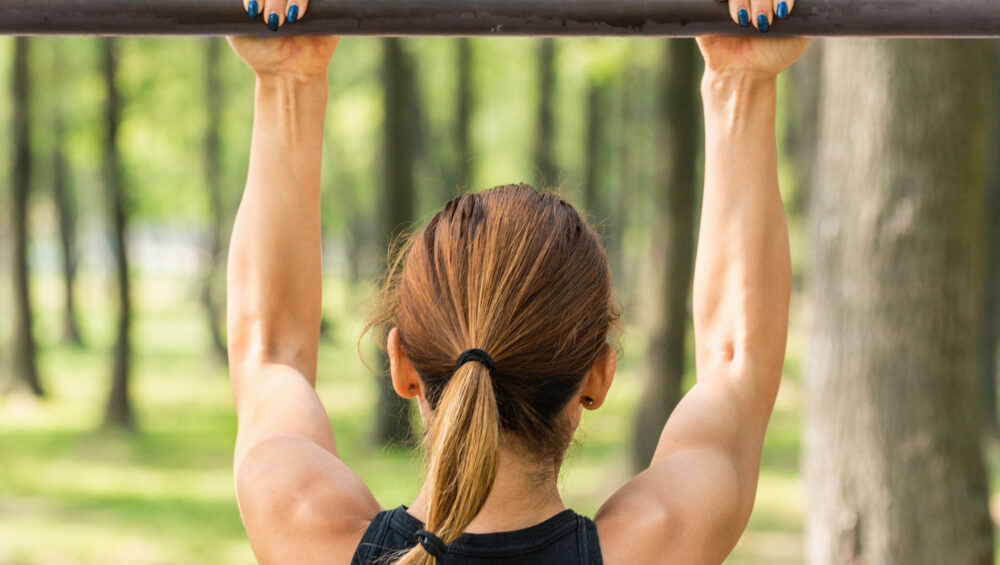I wanted to highlight some of my thoughts and programming suggestions on the topic. Don’t get me wrong: To get better at any activity – pull-ups, chess, baking, fighting grizzly bears – you need to actually do the activity. Specificity reigns supreme. I’ve highlighted several ways to progress one’s pull-up prowess on this site before.
I mean, you’re not here for Macadamia Nut Cookie recipes, or, I don’t know, best uses of tape.1
As such, I figured I’d take today to highlight a few of my “go to” non-pull-up exercises that help build the pull-up.
Lets get to it.
NOTE: Before anyone chimes in with the inevitable snide comment that the picture above is a silhouette of chin-up and not a pull-up, I get it.
You’re a hero.
A Quick Aside
I work with many clients – both male and female – who are very interested in performing their first strict, bodyweight pull-up.
And, to no big surprise, they’ve likely been told, via various articles and coaches, to hammer the same two exercises time and time and time again:
- Eccentric Only Pull-Ups
- Band Assisted Pull-Ups
Kind of like their own version of Groundhog Day hell.
Except without all the LOLs.
Suggesting those two exercise is not altogether bad advice.
I mean, in the name of specificity I implement them all the time too.
However, it’s a bit shortsighted and derails one key component of pull-up training I feel many trainees (and coaches) tend to overlook:
NO PANTS FREQUENCY
If you want to conquer your first pull-up…
- You need to train it more often.2
AND
- To that end, you need to provide a more diverse training menu (so you can train it more often).
Whenever I work with someone who’s main goal is to perform their first pull-up I try to implement an exercise or drill EVERY session that nudges him or her towards that goal.
Like the Hollow Position “Pull-Up” I discussed the other day HERE.
So, yeah, this means I do include exercises like Band Assisted or Eccentric Only Pull-Ups. It also means I utilize various hanging leg raise exercises (knees bent 90 degrees, straight-leg, etc), bent-arm hang holds (chin above bar and hold for time), tons and tons of rows, and/or various pulldown exercises.
But here’s a few more for you to consider.
1. Bear Stance Fallout
I got this one from Virginia based strength coach Vernon Griffith. I don’t think he posted it as a drill to help build the pull-up, but I’ve been using it as such because it HAMMERS the core (which is often a weak link for many trainees) in addition to teaching more of a “pulling” action back to the starting position (which carries over to the pull-up).
To be fair, I would always start out with plain ol’ push-ups and making sure people get proficient at them first. I have yet to see someone improve on their push-up technique (and ability to do more) and not see an improvement in pretty much everything else – squats, deadlifts, pull-ups, arm wresting a great white shark, you name it.
That said, if you’re looking to up the ante a bit give this drill a go.
2. Bottoms-Up Carry w/ Band
This may make zero sense to some, but hear me out.
“Connectivity” of the pelvis to the ribcage is huge. The pull-up is more of a FULL-BODY exercise than people give it credit for, and if someone is flailing all over the place while attempting it it makes sense why they may be having a hard time progressing.
This drill helps to build some context of the CONNECTION I am after while also building a set of sturdy shoulders.
3. Rack Pull-Up
4. Leg Assisted Pull-Up
I don’t have anything profound or sciency to add to this drill other than I like it for nothing else than it just gives people a nice confidence boost. I also like it because there’s a degree of specificity tethered to it (I.e., it’s a vertical pull, but still not quite actual pull-up territory).
Or, maybe it is.
Whatever.
And That’s That
For me, the main goal of getting someone to perform their first pull-up is to attack it more frequently and provide them more exposure to an array of exercises that will help them get there.
I hope these make sense and you can use them yourself!
- Wrapping presents, leaving notes on the door, hanging mid-90’s Lil Kim posters on your wall. You know, stuff like that.
- And by “it” I don’t necessarily mean the actual pull-up. Just like we use accessory movements to build our deadlifts and squats and to address weaknesses and technique issues, we can use the same logic towards the pull-up.



